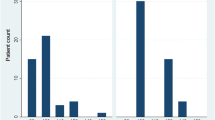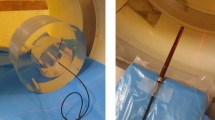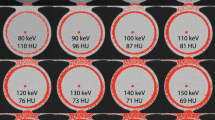Abstract
The aim of the study was to evaluate radiation exposure of a chest pain protocol with ECG-gated dual-source computed tomography (DSCT). An Alderson Rando phantom equipped with thermoluminescent dosimeters was used for dose measurements. Exposure was performed on a dual-source computed tomography system with a standard protocol for chest pain evaluation (120 kV, 320 mAs/rot) with different simulated heart rates (HRs). The dose of a standard chest CT examination (120 kV, 160 mAs) was also measured. Effective dose of the chest pain protocol was 19.3/21.9 mSv (male/female, HR 60), 17.9/20.4 mSv (male/female, HR 80) and 14.7/16.7 mSv (male/female, HR 100). Effective dose of a standard chest examination was 6.3 mSv (males) and 7.2 mSv (females). Radiation dose of the chest pain protocol increases significantly with a lower heart rate for both males (p = 0.040) and females (p = 0.044). The average radiation dose of a standard chest CT examination is about 36.5% that of a CT examination performed for chest pain. Using DSCT, the evaluated chest pain protocol revealed a higher radiation exposure compared with standard chest CT. Furthermore, HRs markedly influenced the dose exposure when using the ECG-gated chest pain protocol.
Similar content being viewed by others
Explore related subjects
Discover the latest articles, news and stories from top researchers in related subjects.Avoid common mistakes on your manuscript.
Introduction
Cardiovascular diseases remain the main cause of death in the western world. [1]. Excision of acute coronary artery syndrome (aCAS) has to be ruled out precisely and with high efficiency. Of all patients with aCAS, 2–6% are discharged inappropriately [2, 3], with possibly fatal consequences. Missed diagnosis is associated with a nearly twofold increase of mortality and is a leading cause of malpractice claims [1, 4, 5].
However, only a minority of patients admitted with acute chest pain but a normal electrocardiogram (ECG) and negative cardiac enzymes are afflicted with aCAS [1]. This results in costly examinations like the measurement of cardiac serum markers, ECG and stress testing [6].
A standard chest CT examination in combination with coronary CT angiography (CCTA) offers the possibility of demonstrating the coronary arteries and the rest of the thorax to exclude an aortic dissection and pulmonary embolism, thereby investigating the three life-threatening causes of acute chest pain.
The radiation dose of a chest pain CT protocol should be at least 50% higher in comparison with CCTA simply because of the increased field of view [1]. However, there are no data for effective dose measurements of chest pain protocols to the authors’ knowledge, leaving possible consequences of higher radiation doses with the increasing use of chest pain CT protocols as a standard means of examination in the dark. Especially in younger patients, this leads to growing concerns and the urge for further investigation. The aim of the present study was to evaluate the radiation exposure of a chest pain CT protocol with ECG-gated dual-source computed tomography (DSCT) and its comparison to that caused by a standard chest CT.
Materials and methods
Dose measurements
Dose measurements were performed using an Alderson-Rando-Phantom (Alderson Research Laboratories) equipped with 117 thermoluminescent dosimeters (TLD) with dimensions of 1 × 1 × 6 mm3 (TLD-100H, Bicron-Harshow Radiation Measurement Products). Before irradiation, the TLDs were equalized with a TLD annealing oven (TLD annealing oven, PTW-Freiburg). The radiation doses absorbed by the individual TLD elements were measured on a TLD reader (Model 5500 TLD Reader, Bicron Radiation Measurement Products) within 6 h after exposure. Calibration was performed using a 1 mGy water energy dose at 100 kV in the simulator.
The dosimeters were placed in 39 different positions in the Alderson-Rando-Phantom for the assessment of organ doses dependent on the anatomical position of each organ. In order to obtain reliable results, three TLDs were placed at each position of dose measurement. In organs which are of major importance for the calculation of the effective dose, several points of measurement were used and averaged.
For the estimation of the organ dose of the lung, 14 points of measurement (42 TLDs) were placed within the simulated lung tissue to get a craniocaudal as well as an in-plane dose profile. For the assessment of the liver dose, measurements were performed in four slices of the phantom using six points of measurement (18 TLDs). The partial volume of the organ in each slice was estimated by using the tables of Zankl et al. [7]. The quantity of TLDs allocated to the other organ positions were as follows: three each at the brain, thyroid gland, esophagus, thymus, heart, breast, stomach, upper colon, spleen, kidneys, adrenal glands, pancreas, small intestine, lower colon, urinary bladder, muscle tissue, red bone marrow, skin, ovaries and testicles. When estimating the effective dose in women, one additional point of measurement was placed in the simulated breast tissue and one point in the ovaries. Each organ dose was weighted by multiplying with the weighting factor provided by ICRP 60. The effective dose was calculated by summarizing the weighted organ doses [8].
Chest pain protocol
The CT examinations for simulated heart rates (HR) of 60, 80 and 100 beats/min were performed using a DSCT system (Somatom Definition, Siemens Medical Solutions) with a standard chest pain protocol [9, 10]. Data acquisition was performed in the supine position and in craniocaudal direction. A topogram was used for planning the examination and determining the craniocaudal distance to be covered. The biphasic chest pain protocol includes a standard CT of the upper thorax and an ECG-gated CT examination of the lower chest. The division line between superior and inferior range was about 2 cm below the carina. In the inferior range, the following electrocardiographic pulsing was adapted automatically according to the simulated heart rate for a maximum tube current within the R-R interval: 55–70% (51–60 beats/min) and 35–70% (61–119 beats/min). For dose savings, the radiation dose was reduced using tube current modulation during the scan according to the the patient’s topogram and diameter (CARE Dose4D, Siemens Medical Solutions). CT parameters are listed in Table 1.
Standard chest protocol
A standard CT examination of the chest was performed with the same DSCT system (Somatom Definition, Siemens Medical Solutions). Data acquisition was again performed in the supine position and craniocaudal direction. A topogram was used for planning the examination and determining the craniocaudal range. CT parameters are listed in Table 1.
Data analysis
Statistical correlation between heart rate and dose exposure was assessed using the Pearson correlation coefficient. Statistical significance was evaluated using the two-tailed paired Student’s t-test. A p-value of <0.05 was considered to be significant.
Results
The estimation of the radiation exposure of the protocols we used resulted in effective doses differing among genders: for women, the estimated effective doses were 14.0% higher compared with men.
Gender specific effective doses of all scan protocols are shown in Table 2 and Fig. 1. The dose exposure showed a negative correlation with a lower heart rate for men and women (r = -0.97). Radiation doses increased significantly with lower heart rates for men (p = 0.040) and women (p = 0.044). The average radiation dose of a standard chest CT examination was about 36.5% of the dose of a CT for chest pain.
Organs within the range of the primary beam revealed organ doses of up to 5.8 mSv (at the side of the lung). The following organs received relatively high doses: female breast, esophagus, liver, stomach, adrenals, spleen and upper colon. Gonad doses were <0.15 mSv in all CT protocols. Details about the organ doses are listed in Table 3.
Discussion
In Europe, chest pain is a common symptom treated in emergency departments and causes costs of about 1.3 billion Euros in France, and up to 3.3 billion Euros in Germany [11]. Acute chest pain is one of the most difficult diagnostic challenges in emergency medicine. Certain elements of the chest pain history of a patient are associated with increased or decreased likelihoods of a diagnosis of acute coronary syndrome, but history alone cannot identify a patient group that could be treated without further diagnostic tests [9, 12]. Furthermore, there are two other life-threatening differential diagnosis of acute chest pain: aortic dissection and pulmonary embolism.
Biphasic chest pain protocols with DSCT angiography of the cardiac structures proved to be a promising tool to evaluate cardiac and non-cardiac causes of acute chest pain in only one examination [9]. Latest results showed a negative predictive value of 97% for coronary artery disease [1] and about 99% for pulmonary artery embolism and aortic dissection for multidetector CT [13, 14].
Multidetector CT is routinely used as a primary diagnostic tool in the emergency work-flow for the assessment of pulmonary embolism [13] and aortic dissection [14]. At present, a new generation of CT systems with two X-ray tubes and detectors (DSCT) has been introduced which improves non-invasive heart imaging due to superior temporal resolution even at high heart rates [10, 15].
Several limitations affect the usefulness of DSCT in the triage of patients with acute chest pain in the emergency department. The heart rate and regularity of rhythm is closely related to image quality and accuracy of coronary artery stenosis detection [16]. However, about 15% of emergency patients have contraindications to beta antagonists, the standard practice to premedicate patients with higher heart rates prior to coronary CT angiography [1]. The new generation of CT equipment (DSCT) with its improved temporal resolution and, therefore, reduced cardiac motion artifacts, allows imaging without any beta blockade in many patients and may help to solve this limitation [1, 10].
However, to the authors’ knowledge there are no recent data available regarding the effective radiation dose applied to the human body by CT using chest pain protocols.
In the present study a tube current time product of 320 mAs (DSCT coronary angiography) was used in order to achieve an optimal image quality of the coronary tree in daily routine. Like in other CT examinations, the radiologist has to decide, depending on the patient’s weight, whether diagnostic image quality is still reachable by the use of a lower tube current. In some cases, the tube current could even have to be increased. In clinical routine, higher estimated doses may be necessary to obtain an image quality suitable for proper diagnosis, especially regarding to the high frequency of obese patients [17].
The CARE Dose4D (Siemens Medical Solutions, Forchheim, Germany) was used for dose saving. This technique allows a dose reduction especially in the area of the shoulder and uses tube current modulation during the scan according to the patient’s topogram and diameter [18].
To achieve a further dose reduction, chest pain CT was performed using ECG-controlled tube current modulation. However, this technique has its limitations in clinical routine, for example, in patients with severe arrhythmia, as the tube current modulation depends on a reliable prediction of the patient’s next R-R interval [19, 20].
Our data show that the radiation exposure is increased in tissues irradiated by the primary beam, whereas it is relatively low outside that range. Therefore, high effective doses are received by the female breast. This causes a higher effective dose for women: values were on average 14.0% higher than for men, with possible consequences regarding the life-time risk of breast cancer.
The amount of dose reduction is dependent on the patient’s heart rate [21]. This study shows a decreasing dose exposure with increasing heart rate, which is an effect of increased pitch values, resulting in less overlaps and reduced radiation exposure. Pitch is defined as the ratio of table feed per gantry rotation to the nominal width of the X-ray beam. However, an increased heart rate tends to lower image quality in clinical routine [22].
Furthermore, the dose measurements revealed a significantly higher radiation exposure in the DSCT chest pain protocol (14.7–21.9 mSv) compared with that for standard CT. A subset of potential patients referred for chest pain CT also require a non-invasive stress test, for example a radionuclide test (exposure about 8–16 mSv), followed in several cases by diagnostic and interventional invasive angiography (5–13 mSv) [1].
The indication for either examination has to take into account the relative procedural risk associated with each examination in comparison with its applied radiation exposure. Chest pain CT protocols seem to be a fast and efficient possibility to evaluate patients with acute chest pain, but more data are necessary to assess their role in clinical routine. Especially in younger patients, the indication for chest pain CT should be set strictly because of the high radiation exposure compared with that of a standard chest CT examination.
References
Gallagher MJ, Raff GL (2008) Use of multislice CT for the evaluation of emergency room patients with chest pain: the so-called “triple rule-out”. Catheter Cardiovasc Interv 71:92–99
Pope JH, Aufderheide TP, Ruthazer R et al (2000) Missed diagnoses of acute cardiac ischemia in the emergency department. N Engl J Med 342:1163–1170
Lee TH, Goldman L (2000) Evaluation of the patient with acute chest pain. N Engl J Med 342:1187–1195
Lee TH, Rouan GW, Weisberg MC et al (1987) Clinical characteristics and natural history of patients with acute myocardial infarction sent home from the emergency room. Am J Cardiol 60:219–224
Karcz A, Korn R, Burke MC et al (1996) Malpractice claims against emergency physicians in Massachusetts: 1975–1993. Am J Emerg Med 14:341–345
Tatum JL, Jesse RL, Kontos MC et al (1997) Comprehensive strategy for the evaluation and triage of the chest pain patient. Ann Emerg Med 29:116–125
Zankl M, Panzer W, Drexler G (1991) The calculation of dose from external photon exposure using reference human phantoms and Monte Carlo methods. Part VI: Organ doses from computed tomographic examinations. GSF-Bericht 30/91. GSF—Forschungszentrum für Umwelt und Gesundheit, Oberschleißheim
Protection ICoR (1991) Recommendation of the International Commission on Radiological Protection. ICRP Publication 60, Pergamon Press, Oxford
Schertler T, Scheffel H, Frauenfelder T et al (2007) Dual-source computed tomography in patients with acute chest pain: feasibility and image quality. Eur Radiol 17:3179–3188
Heuschmid M, Burgstahler C, Reimann A et al (2007) Usefulness of noninvasive cardiac imaging using dual-source computed tomography in an unselected population with high prevalence of coronary artery disease. Am J Cardiol 100:587–592
Taylor MJ, Scuffham PA, McCollam PL et al (2007) Acute coronary syndromes in Europe: 1-year costs and outcomes. Curr Med Res Opin 23:495–503
Swap CJ, Nagurney JT (2005) Value and limitations of chest pain history in the evaluation of patients with suspected acute coronary syndromes. JAMA 294:2623–2629
Quiroz R, Kucher N, Zou KH et al (2005) Clinical validity of a negative computed tomography scan in patients with suspected pulmonary embolism: a systematic review. JAMA 293:2012–2017
Hayter RG, Rhea JT, Small A et al (2006) Suspected aortic dissection and other aortic disorders: multi-detector row CT in 373 cases in the emergency setting. Radiology 238:841–852
Achenbach S, Ropers D, Kuettner A et al (2006) Contrast-enhanced coronary artery visualization by dual-source computed tomography–initial experience. Eur J Radiol 57:331–335
Raff GL, Gallagher MJ, O’Neill WW et al (2005) Diagnostic accuracy of noninvasive coronary angiography using 64-slice spiral computed tomography. J Am Coll Cardiol 46:552–557
Yoshimura N, Sabir A, Kubo T et al (2006) Correlation between image noise and body weight in coronary CTA with 16-row MDCT. Acad Radiol 13:324–328
Althen JN (2005) Automatic tube-current modulation in CT–a comparison between different solutions. Radiat Prot Dosim 114:308–312
Poll LW, Cohnen M, Brachten S et al (2002) Dose reduction in multi-slice CT of the heart by use of ECG-controlled tube current modulation (“ECG pulsing”): phantom measurements. Rofo 174:1500–1505
McCollough CH, Primak AN, Saba O et al (2007) Dose performance of a 64-channel dual-source CT scanner. Radiology 243:775–784
Stolzmann P, Scheffel H, Schertler T et al (2008) Radiation dose estimates in dual-source computed tomography coronary angiography. Eur Radiol 18:592–599
Primak AN, McCollough CH, Bruesewitz MR et al (2006) Relationship between noise, dose, and pitch in cardiac multi-detector row CT. Radiographics 26:1785–1794
Author information
Authors and Affiliations
Corresponding author
Rights and permissions
About this article
Cite this article
Ketelsen, D., Luetkhoff, M.H., Thomas, C. et al. Estimation of the radiation exposure of a chest pain protocol with ECG-gating in dual-source computed tomography. Eur Radiol 19, 37–41 (2009). https://doi.org/10.1007/s00330-008-1109-4
Received:
Accepted:
Published:
Issue Date:
DOI: https://doi.org/10.1007/s00330-008-1109-4





